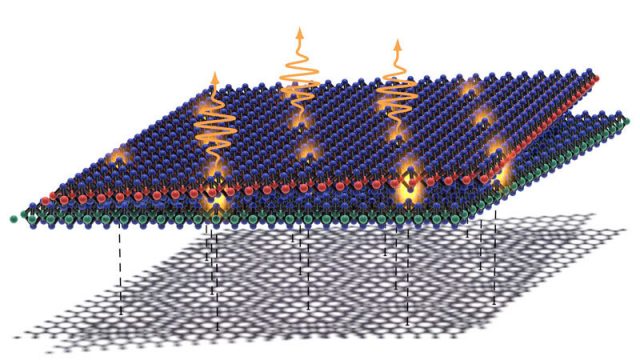A paper by the Quantum Photonics Lab at Heriot-Watt, published today in top-tier Nature Materials, identifies how to trap interlayer excitons (IXs) and their quantum fingerprints. The IXs are trapped by the interaction of two sheets of atoms made of different transition metal dichalcogenides (TMDs), which are stacked together with a small twist to form a moiré pattern.
For the less quantum-literate, or more fashion-minded, moiré interference patterns emerge whenever two similar but slightly offset templates are combined—such as silk fabric that has been subjected to heat and pressure to give it a rippled appearance. In the Quantum Photonics Lab, led by Professor Gerardot, the moiré patterns affect the key properties of atomic heterostructures to create a new quantum material.
Two-dimensional (2-D) materials, such as graphene or TMDs, can form a variety of heterostructures held together by weak van der Waals (vdW) forces, endowing scientists with a rich toolbox for engineering their optoelectronic properties. VdW multilayers may also form moiré patterns—a periodic variation of the alignment between corresponding atoms in adjacent layers—by twisting the sheets by a relative angle and/or combining materials with different lattice constants.
In addition, peculiar features derive from the 2-D nature of the TMD layers including a phenomenon named spin-valley-layer locking, which open up potential connections to the larger fields of spintronics and valleytronics that are of interest for next-generation optoelectronic devices.
Professor Gerardot explains the significance of his findings: “Interlayer excitons trapped in atomic moiré patterns hold great promise for the design of quantum materials based on van der Waals heterostructures, and investigations on their fundamental properties are crucial for future developments in the field.”
Find your dream job in the space industry. Check our Space Job Board »
The scientific community still seeks strategies to verify the nature of the trapping sites and understand the role of sample imperfections. A combination of experimental methods could be employed to clarify the role of atomic reconstruction, strain and other defects, correlating optical measurements and non-invasive microscopy techniques.
The Quantum Photonics Lab is designing fully tuneable electronic devices, based on the twisted quantum materials, to fully understand how the moiré can interact with each other and be exploited for quantum optics applications.
Within a field particularly rich in opportunities, science moves at an impressive pace and many breakthroughs can be expected.
Provided by: Heriot-Watt University
More information: Mauro Brotons-Gisbert et al. Spin–layer locking of interlayer excitons trapped in moiré potentials. Nature Materials (2020). DOI: 10.1038/s41563-020-0687-7
Image: Two layers of atoms being twisted to form a moiré pattern, shown in the shadow, which traps light-emitting particles.
Credit: Heriot-Watt University











